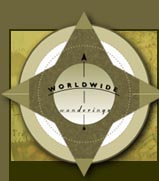Nov.
3-8, 1998 Nile Cruise, EgyptThe canopy that provides my shade
squeaks and groans as it flaps up and down in the stiff breeze of the oncoming wind. The
grinding of the tether as it rubs against its metal skeleton is the only sound I hear as
we drift, with the current, slowly and peacefully down the Egyptian Nile. A strip of palms
line each side of this mighty river, for she is the blessed mother of all life, forcefully
and defiantly ripping her way through the scorched dessert sands of the Sahara, North to
the Mediterranean Sea. There is an occasional whistle or shout of greeting as the
gallabiya (robe type garments) clad fishermen or farmers look up from their activity to
wave hello to our passing boat.
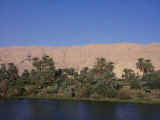 All
of life in Egypt, both past and present, is centered around the currents of the Nile. It
alone dictates the story of the rise, fall, and rise again of this, one of the
world’s oldest lands. It is nothing short of an inexplicable blessing of nature that
the Nile has not simply dried up, but instead stubbornly survived, and been a key part of,
the thousands of years of drastically changing landscape that has literally moved
mountains. Moved mountains of sand that have, and certainly still do, hide the 40-60 foot
high monuments and temples underneath them. Although hidden, all is not hopeless. For we
know that, if they do exist, they are most certainly within the confines of the Nile
Valley. In new as well as old, the valley is the hub of all activity. Almost all of
Egypt’s 58 million people live in the valley. A refreshing green and pleasant sight,
fields of cotton, corn, and sugar cane grow in this stretch that is 15 miles at its
widest, and 300 feet across at its narrowest.
All
of life in Egypt, both past and present, is centered around the currents of the Nile. It
alone dictates the story of the rise, fall, and rise again of this, one of the
world’s oldest lands. It is nothing short of an inexplicable blessing of nature that
the Nile has not simply dried up, but instead stubbornly survived, and been a key part of,
the thousands of years of drastically changing landscape that has literally moved
mountains. Moved mountains of sand that have, and certainly still do, hide the 40-60 foot
high monuments and temples underneath them. Although hidden, all is not hopeless. For we
know that, if they do exist, they are most certainly within the confines of the Nile
Valley. In new as well as old, the valley is the hub of all activity. Almost all of
Egypt’s 58 million people live in the valley. A refreshing green and pleasant sight,
fields of cotton, corn, and sugar cane grow in this stretch that is 15 miles at its
widest, and 300 feet across at its narrowest.
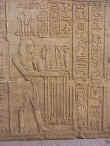 After flying in from Cairo, we begin our journey at the start of the
Egyptian part of the Nile. The river is really born from the waters of Lake Victoria,
Tanzania, but her journey across Egypt begins just outside the city of Aswan from the
feedings of Lake Nasser, the largest man-made lake in the world, bordered on one shore by
the Aswan High Dam. We land Aswan airport at 6:30 that morning. Our luggage is taken to
the ship, as we board another plane for the 30 minute flight to Abu Simbel.
After flying in from Cairo, we begin our journey at the start of the
Egyptian part of the Nile. The river is really born from the waters of Lake Victoria,
Tanzania, but her journey across Egypt begins just outside the city of Aswan from the
feedings of Lake Nasser, the largest man-made lake in the world, bordered on one shore by
the Aswan High Dam. We land Aswan airport at 6:30 that morning. Our luggage is taken to
the ship, as we board another plane for the 30 minute flight to Abu Simbel.
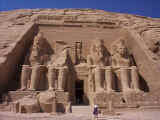 As we
get off the bus, our guide instructs us to walk around the huge hill of sand, as he will
join us there. We do as we are told, and as we turn the corner - there it is. The larger
than life and ah so awe-inspiring, Temple of Ramses II. It is this site that many consider
the most astounding of all of the ancient Egyptian monuments.
As we
get off the bus, our guide instructs us to walk around the huge hill of sand, as he will
join us there. We do as we are told, and as we turn the corner - there it is. The larger
than life and ah so awe-inspiring, Temple of Ramses II. It is this site that many consider
the most astounding of all of the ancient Egyptian monuments.
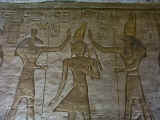 And at this moment, I fully agree. The four colossal statues of this, the
most vain of all the pharos, stand (actually he’s seated) 65 feet high to face the
rising sun. What makes this temple particularly fascinating (aside from its sheer
magnitude), is that its unusual facade was carved out of a single piece of rock, rather
than constructed from many large pieces. Not only is the temple’s facade a work of
extraordinarily sophisticated stone masonry, but the interior, also having been hewn from
solid rock, rather than constructed from blocks, displays very impressive skill (as well
as patience).
And at this moment, I fully agree. The four colossal statues of this, the
most vain of all the pharos, stand (actually he’s seated) 65 feet high to face the
rising sun. What makes this temple particularly fascinating (aside from its sheer
magnitude), is that its unusual facade was carved out of a single piece of rock, rather
than constructed from many large pieces. Not only is the temple’s facade a work of
extraordinarily sophisticated stone masonry, but the interior, also having been hewn from
solid rock, rather than constructed from blocks, displays very impressive skill (as well
as patience).
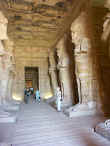 Penetrating
into the heart of the mountain, we find the sanctuary at the far reaches of the temple
where the ‘miracle of the sun’ takes place. These early engineers were so
sophisticated that they built this small room at exact angles so as to have a narrow ray
of sun reach over 200 feet into temple to bathe three of the four seated gods (Ptah, the
god of darkness was purposely excluded), one at a time, for about 6 minutes each, twice
each year.
Penetrating
into the heart of the mountain, we find the sanctuary at the far reaches of the temple
where the ‘miracle of the sun’ takes place. These early engineers were so
sophisticated that they built this small room at exact angles so as to have a narrow ray
of sun reach over 200 feet into temple to bathe three of the four seated gods (Ptah, the
god of darkness was purposely excluded), one at a time, for about 6 minutes each, twice
each year.
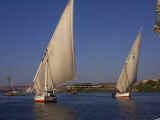 We spend that afternoon taking a relaxing cruise on one of the
local feluccas. Totally wind-powered and nearly completely unchanged in design since the
days of their invention, these silent craft provide the perfect means of transport to
explore the upper Nile on a more intimate level.
We spend that afternoon taking a relaxing cruise on one of the
local feluccas. Totally wind-powered and nearly completely unchanged in design since the
days of their invention, these silent craft provide the perfect means of transport to
explore the upper Nile on a more intimate level.
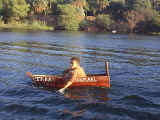 During
our excursion we are occasionally serenaded by young boys in their box boats who take a
break from their rowing (and bailing) to hitch a ride on our boat and sing us a tune.
Nightfall sees us to a local coffee house where we comfortably lounge around and sample
some of the local refreshments - Dom and Yenson - while I happily puff on my apple tobacco
filled water pipe, or shisha.
During
our excursion we are occasionally serenaded by young boys in their box boats who take a
break from their rowing (and bailing) to hitch a ride on our boat and sing us a tune.
Nightfall sees us to a local coffee house where we comfortably lounge around and sample
some of the local refreshments - Dom and Yenson - while I happily puff on my apple tobacco
filled water pipe, or shisha.
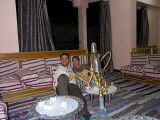 The next day, a short cruise down the Nile brings us to the temple Kom
Ombo. This double temple (dedicated to both Sobek and Horus) is situated high upon a mound
above the river bank. Sobek, the crocodile god, was paid homage by the sacrifice and
mummification of hundreds of his real-life counterparts, the crocodiles of the Nile.
The next day, a short cruise down the Nile brings us to the temple Kom
Ombo. This double temple (dedicated to both Sobek and Horus) is situated high upon a mound
above the river bank. Sobek, the crocodile god, was paid homage by the sacrifice and
mummification of hundreds of his real-life counterparts, the crocodiles of the Nile.
